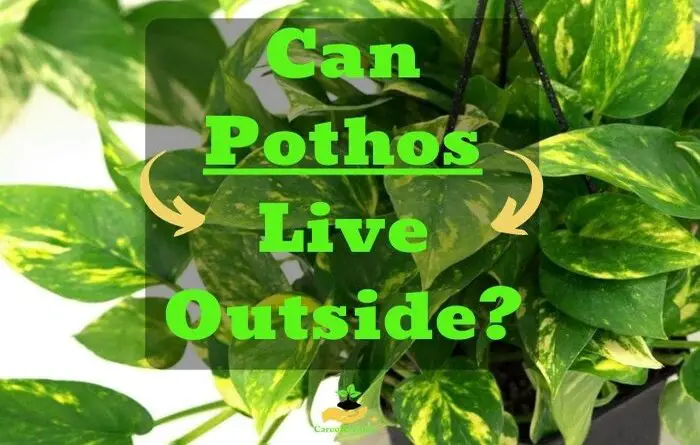Can Pothos Live Outside? (Here is the Answer)
The pothos is the houseplant par excellence . For this reason it is not usual to imagine pothos outdoors but we asked the following question: Can Pothos Live Outside?
Its long stems and splendid green leaves have always been a furnishing element for our homes, giving vivacity and elegance to any environment.
Pothos is an extremely tolerant houseplant that often grows under the fluorescent lights of office buildings. What about growing pothos outside? Actually, yes, an outdoor pothos plant is a possibility.
Keep reading to learn more about pothos outdoors and caring for pothos outdoors.
Can Pothos Live Outside?
Many do not know that the Pothos can also be grown outside in our gardens even if it is a delicate plant, if the outside temperature is between 64°F and 77°F (18 and 25°C) and live in an area in USDA zones 10 to 12. Due to its tropical origins, the pothos appreciates particularly humid and warm environments.
Pothos is essentially a plant of tropical origin native to the Solomon Islands which therefore by definition has great needs for heat and humidity. Therefore you want photos to live outside will be necessary to try to reproduce those climatic conditions: grow it in a warm environment, with few thermal changes (because it does not tolerate temperatures below 50°F / 10 ° C) and with a good humidity rate.
Pothos is not grown outside, except in areas where the climate is warm in the winter season. If you live in a cold climate, such as Northern Europe, the Northern part of the US and Canada or the Southern Hemisphere parts of South America, it is way too cold for pothos plants to live outside, especially in winter.
What Does the Pothos Need to Live Outside?
Pothos can thrive outdoors very easily if some minimum requirements are met for its care:
| Requirements for Pothos to Live Outside | |
|---|---|
| Location | Pothos prefers bright or semi-shady outdoor places without drafts. Falling leaves and purely green colored leaves are an indication of a lack of light in pothos. |
| Temperature | Pothos prefers warm temperatures outside between 64°F and 77°F (18 – 25°C). As a tropical plant, it does not tolerate outside temperatures below 59°F ( 15°C). |
| Water | Water weekly. The substrate should be slightly dry before each new watering. The higher the temperature, the more water the pothos needs. |
| Fertilizer | A liquid fertilizer can be added to the irrigation water every two weeks. |
| Warning | All parts of the plants are toxic, especially to small children and pets, if ingested in large quantities |
In order for your pothos to thrive outside , it is essential that it has the right conditions such as light, temperature and humidity.
Temperature
Pothos loves humidity and heat. If the outside temperature allows it, between 64°F and 77°F (18 and 25°C), you can take out the pothos between May and September. Pothos plant does not particularly like temperatures below 15 degrees Celsius, which you can see from dark leaf spots after a while if in doubt .
The ideal temperature for Pothos plants outside is between 15-26°C (60°F and 80°F). Outdoor pothos tolerates a wide range of temperatures well ranging from 50°F – 84°F (10 to 29 °C ) generally.
If you find that temperatures are too high in the summer or too cold in the winter, then move it indoors if you can to protect it from these extremes.
If your Pothos plant has blackened leaves and little to no growth, you should consider moving your plant to a warmer location. And if temperatures are too low, Pothos vines tend to stop growing.
Light
Outdoors, the pothos plant will flourish in shade or partial shade. Almost the only kind of light that plants can’t stand is direct sunlight. Direct sunlight can cause unsightly burns , especially in summer.
The pothos prefers a partially shaded to light location without direct sun. The more the leaves are patterned, the more light they need. If the location is darker, the foliage will turn green and the marbling will fade.
If you want pothos to live outside, plant them in a shady spot. They prefer bright, but no direct sunlight. You can place them near a window or in a dark corner, as they tolerate even the lowest light conditions.
Soil
If you want to keep the pothos outside, it is best to use high-quality soil. In addition, it is also possible to keep them in hydroponics, in which no soil is required. The substrate must be permeable so that water does not accumulate.
The most suitable soil for pothos to live outside is composed by a mixture of garden soil mixed with 1/3 of leaf soil and a little sand that will be well-drained. That it does not puddle when watering.
If exposed to the elements, drainage is essential if you do not want the soil to remain soaked.
This could lead to root rot and damage your plant. Aim for a soil pH between 6.1 and 6.5, but they aren’t really picky, unless the soil is too acidic (less than 5.8 pH). Make sure the soil is moist, but not soggy.
Make sure you do a good mulch , which can retain the right moisture , which is difficult to control in an outdoor environment.
Water
For pothos that live outside is necessary to give it a little more water than when growing it indoors because the temperatures are distinctly different.
If the first few inches of soil seem dry , then water it. Generally, in the warmer months it needs to be watered at least twice a week.
The basic rule is that pothos should only be watered moderately and the top layer of soil should dry slightly before the next watering. Avoid waterlogging and pour off excess water.
Watering should be moderate during the growth period, i.e. the surface of the soil should be allowed to dry out for 2 cm before watering again. During the rest period, water sparingly to prevent the substrate from drying out completely and stop adding fertilizer.
As a general rule of thumb, pothos plants should be watered every one to two weeks in the warmer months and every two to three weeks in the cooler months.
In general, the soil should be kept moist with regular watering. But as a general rule, it is better that it stays a little dry rather than the land has stagnation.
Fertilizer
Although the pothos plant is an extremely easy-care houseplant that can do without fertilizer, for optimal care it should receive a weekly to 14-day dose of foliage plant fertilizer during the growing season between March and August.
Although it is not a very demanding plant, a pothos will need fertilizer to develop properly outside and grow strong.
The simplest and most ecological thing is to get compost (if you have space you can even make it yourself) and apply a couple of centimeters of organic matter to the substrate, at the base of the plant, every 15 days.
If not, universal fertilizer will also work fine. In any case, apply the fertilizer especially during the warm months , from spring to summer, letting the pothos plant to rest afterwards.
In spring, fertilize it so as to make the soil rich in nutrients again. You can use DIY fertilizers if you don’t want to use common over-the-counter fertilizers.
Pests
The most common pest of pothos plants is mealybug. If the leaves on your plant start to turn yellow, the cause could be a mealybug infestation.
These insects will live and feed on your plant, eventually killing it if not treated immediately. If your pothos is growing outdoors, you might consider using ladybugs to help control the mealybug population.
How To Grow Pothos Outside
Pothos is an undemanding climbing plant. It likes any exposure: sun, partial shade, shade. However, give variegated pothos a few hours of daily sunlight to keep their variegation. Both poor and rich soil suit it.
Pothos is such a common houseplant because of how easily it thrives in a variety of conditions. It will happily grow outdoors in shade or partial shade or indoors if it receives bright indirect light.
In regions with a milder climate it is possible to grow it close to a wall, on pergolas or on trees. In the garden, grow it in fertile but well-drained soil, in full sun or partial shade.
Also know that this plant is poisonous, if ingested, it can cause serious problems and contact with its sap could irritate your skin.
Pothos goes into the ground all year round. Its establishment is faster if it is planted in spring or autumn. Avoid planting pothos during frost.
The Pothos also excels in low light conditions or in bathrooms and offices where there is no natural sunlight. In the absence of natural light, pothos needs 12 to 14 hours a day of artificial light to thrive.
Pothos really isn’t picky about the soil it grows in and can grow strong well in gravelly or otherwise poor soil as long as it gets sufficient drainage and the soil isn’t too wet. In fact, as a houseplant, pothos is sometimes grown in water without any soil in the container.
A pothos can live a normal lifespan of five to 10 years in water as long as you provide it with an all-purpose liquid fertilizer. Follow package directions for dosage amount and timing.
Outdoor Pothos Maintenance
Both indoor and outdoor pothos plants are easy to care for with few disease or pest problems. That said, pothos plants can be susceptible to mealybugs or scale insects, but a cotton ball dipped in alcohol or a horticultural spray treatment should eradicate the pest in no time.
A healthy pothos growing outdoor adds a tropical flair to the landscape and an outdoor pothos can have another benefit that those grown indoors lack; some plants can flower and produce berries, a rarity among pothos houseplants.
Pothos in the garden may be allowed to climb trees and trellises or simply meander along the garden floor. Its pruning can be left unchecked or delayed with pruning.
Pothos soil should dry out between waterings, do not let the plant sit in water. Allow only the top 2 inches (5 cm) of soil to dry out before watering again. Overwatering is the one area where pothos are picky. If you see yellowing of the leaves, the plant is overwatered. If you see wilted or brown foliage, water more often.
When the soil becomes dry on the surface, moderate watering of the plant is recommended. On the other hand, it is necessary to avoid excess water so as not to damage the roots and cause them to rot. Even in winter, pothos has a very limited need for water. Watering must therefore be punctual.
To help it flourish, an ambient temperature of 18 to 25°C is recommended. Regular cleaning of the leaves with a cloth soaked in water will give more shine to the shiny foliage of the pothos: do not hesitate!
A supply of organic fertilizer can be beneficial to stimulate its growth and bring it a little tone, but is not essential.
Conclusion
In conclusion pothos can live outside if the temperature is between 64°F and 77°F (18 – 25°C) and has a shady location where the direct sun is avoided because of their low-maintenance and easy-going nature. They are perfect for a novice gardener or the busy one and can thrive both indoors and outdoors.
If you consider to plant pothos outside see if you live in a climate similar to the plant’s natural habitat. Pothos can be used as a ground cover in a corner of the garden that lacks light and where no other plants grow.
If you take good care of the pothos, it can live for over 25 years.
The pothos is a very frugal plant and can survive for several days without water.
Pothos is not a hardy plant and does not tolerate temperature below 10°C and that is why it prefers summer temperature of 68°F (20°C ).
Please note that growing pothos outdoors is only possible where the climate is relatively warm in winter. They do not tolerate temperatures below 50 F. Therefore, if you live in a place where the temperature drops below 50 F in winter, it is best to plant it in a pot.




